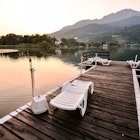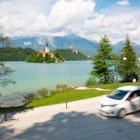
Riding rocks, rails and reservoirs, half a mile underground, in Slovenia
Sponsored by
- placement: logo
- path: articles/header-badge-logo
- possible size: [1, 1],
- targeting:
{ "url": "slovenia-mezica-mine-adventure" }

Aug 18, 2022 • 5 min read

At Eastern Slovenia's Mežica Mine you can explore the upper reaches of the mine by bike, descend to the lowest levels by train, and go kayaking along the lakes of spring water that have pooled half a mile (800m) below ground © Photo courtesy of Podzemlje Pece
Slovenia’s remote Koroška (Carinthia) region, a mountainous area running along the country’s northern border with Austria, is firmly off the beaten track. Even for Slovenians, this traditionally industrial district feels out of the way, and most visitors come to see the unique experiences around Unesco-listed, cross-border Karavanke Geopark. But I’ve come to find out what this under-the-radar region offers for intrepid travelers, and my guide for the journey – Matej Kandare, director of Slovenia Outdoor – has promised several days of excitement.
- placement: fullWidth
- path: articles/in-content-top
- possible size: [970, 250], [970, 90], [728, 90], [300, 250], [320, 50], [1, 1],
- targeting:
{ "url": "slovenia-mezica-mine-adventure" }
On this day, he’s planned a trip to Koroška’s Mežica Mine, a former lead and zinc extraction facility buried deep within a 7,000ft (2,125m)-high outcropping called Mt Peca. I express polite interest – how exciting can a lead mine be? I had no idea I was about to embark on an adventure I’ll remember the rest of my life.

The ‘Valley of Death’
We arrive on a sunny, early-summer morning. Over coffee, I learn about the mine from one of the coordinators of the Geopark, Suzana Fajmut Štrucl, and mine guide Marko Ivčić. From Roman times to the end of the last century, the mine was a bountiful source of lead ore and rare minerals. Over the centuries, nearly 600 miles (1,000km) of excavation tunnels were burrowed into the mountain to a depth of nearly 3,300ft (1,000m).
Working conditions for the miners were so harrowing, the mine and surrounding areas were referred to as the ‘Valley of Death.’ My ears perk up at that last part, but my hosts assure me the mine is perfectly safe for a short-term visit.
I’m still not certain what we’ll be doing in the mine, until I see Marko wheel over a couple of mountain bikes, along with helmets and miner-style headlamps. Flashing a smile, he tells us the plan for the morning is to explore the upper reaches of the mine by bike. Then in the afternoon we’ll descend to the lowest levels by train, and go kayaking along the lakes of spring water that have pooled half a mile (800m) below ground.
I feel a twinge of claustrophobia, that’s quickly overridden by curiosity.
- placement: fullWidth
- path: articles/in-content-middle
- possible size: [970, 250], [970, 90], [728, 90], [300, 250], [320, 50], [1, 1],
- targeting:
{ "url": "slovenia-mezica-mine-adventure" }

Under-the-mountain biking
A blast of cold air greets us as we push open the heavy metal doors to the mine and walk our bikes inside. Temps below ground hover around 50 degrees Fahrenheit (10 degrees Celsius) year-round, and we’re wearing spring jackets to stay warm. Our eyes need a couple of minutes to adapt to the blackness. Marko starts the ride off slowly to allow us to adjust to the path’s narrow, uneven terrain and occasionally low-hanging ceilings. But soon he picks up the pace and the exhilaration of cycling inside of a mountain kicks in.
The surface is rock-strewn but flat; the length of the trail, about 3 miles (5km), is suited to a confident beginner or intermediate rider (and kids over the age of 10). Advanced mountain bikers may want to try their luck the mine’s more challenging track, dubbed the “Black Hole,” etched ominously into the mine’s even-narrower crevices.
Every 10 minutes, Marko pauses to point out some of the mine’s features: giant caverns of natural beauty, or big, rusting buckets of ore sitting for decades and which attest to the day-to-day difficulties of working a mine. Here and there he points to surviving veins of white, gem-like calcite or rarer, rust-brown wulfenite still embedded in the walls (an on-site museum highlights the many metals and minerals that have been found inside the mine). After a little more than an hour of riding, we re-emerge smiling – if temporarily blinded – into the bright summer sunshine.

Underground rails and reservoirs
For the afternoon adventure, Suzana has promised a train trip, and in my mind I picture a typical ride with comfortable seats and windows. Instead, Marko, Matej and I climb into a tiny box of a carriage, windowless and firmly locked.
These carriages, each no wider than the length of my arm and only a few feet long, were once used to carry as many as eight miners at a time as deep as 1.8 miles (3km) below the surface. It’s hard to imagine today – the carriage feels cramped with just the three of us inside. Bent over in that dark box, rattling ever-downward into the mine, I have a deep appreciation for the educational aspect of our visit. This, after all, was a daily reality for thousands of men who once worked these seams.
Once inside the mine we put on helmets, headlamps and gloves, and descend a further 600 steps to the chamber’s low-lying pools of fresh water. Here, we pause momentarily in a heated dressing room to don chest-high waders that will protect us from the chilly (43°F / 6°C) water. After another careful descent along damp, concrete steps, we walk into the water and fetch our kayaks.
For the next 45 minutes, we’re free to aim our boats wherever we want and to follow the narrow channels wherever they lead. At half a mile below the ground, the space feels unexpectedly airy and peaceful; the silence is broken only by our laughter and the sounds of paddles dipping into the clear water. Through the glint of my lamp, the water throws back shades of green and blue. It looks so refreshing and inviting, I feel a temporary urge to dive in (and then I remember the temperature).
It dawns on me I’ll likely never forget this moment.

Practical information
The mine’s activities are not recommended for people who experience serious claustrophobia, children below the age of 12 and those without at least an intermediate level of fitness. The mine is best reached by car. Advance reservations are required for all tours. There are plenty of other adventures unique to Slovenia in the region. For instance, the Slovenian Coal Mining Museum in Velenje, 40km (25 miles) southeast of Mežica, offers four-course gourmet meals served in the mine.
Sponsored by Slovenia Tourism
As a travel entertainment and inspirational media outlet, we sometimes incorporate brand sponsors into our efforts. This activity is clearly labeled across our platforms.
This story was crafted collaboratively between Slovenia Tourism and Lonely Planet. Both parties provided research and curated content to produce this story. We disclose when information isn’t ours.
With sponsored content, both Lonely Planet and our brand partners have specific responsibilities:
Brand partner
Determines the concept, provides briefing, research material, and may provide feedback.
Lonely Planet
We provide expertise, firsthand insights, and verify with third-party sources when needed.
- placement: fullWidth
- path: articles/bottom
- possible size: [970, 250], [970, 90], [728, 90], [300, 250], [320, 50], [1, 1],
- targeting:
{ "url": "slovenia-mezica-mine-adventure" }
Explore related stories









